Ionization Radiation Shielding Effectiveness of Lead Acetate, Lead Nitrate, and Bismuth Nitrate-Doped Zinc Oxide Nanorods Thin Films: A Comparative Evaluation
Abstract
1. Introduction
2. Materials and Methods
2.1. Materials
2.2. Synthesis of ZnONR-TFs Using CBD Technique
2.3. Characterization of as Made ZnONR-TFs
3. Results and Discussion
3.1. Morphological and Structural Characterization of ZONRs-TFs
3.2. Evaluating the Radiation Attenuation Capability of ZONRs-TFs
3.3. Effect of Film Thickness and Porosity on µ of Optimally Doped ZONRs-TFs
3.4. Comparative Insights to the Findings
4. Conclusions
Supplementary Materials
Author Contributions
Funding
Acknowledgments
Conflicts of Interest
References
- Abunahel, B.M.; Ramli, R.M.; Quffa, K.M.; Azman, N.Z.N. Effect of nanofibrous porosity on the X-ray attenuation properties of electrospun n-Bi2O3/epoxy–polyvinyl alcohol (PVA) nanofiber mats. Appl. Phys. A 2018, 124, 1–9. [Google Scholar] [CrossRef]
- Pearce, M.S.; Salotti, J.A.; Little, M.P.; McHugh, K.; Lee, C.; Kim, K.P.; Howe, N.L.; Ronckers, C.M.; Rajaraman, P.; Craft, A.W. Radiation exposure from CT scans in childhood and subsequent risk of leukaemia and brain tumours: A retrospective cohort study. Lancet 2012, 380, 499–505. [Google Scholar] [CrossRef]
- Asefa, G.; Getnet, W.; Tewelde, T. Knowledge about radiation related health hazards and protective measures among patients waiting for radiologic imaging in Jimma University Hospital, Southwest Ethiopia. Ethiop. J. Health Sci. 2016, 26, 227–236. [Google Scholar] [CrossRef][Green Version]
- Calzada, E.; Grünauer, F.; Schillinger, B.; Türck, H. Reusable shielding material for neutron-and gamma-radiation. Nucl. Instrum. Methods Phys. Res. Sect. A Accel. Spectrometers Detect. Assoc. Equip. 2011, 651, 77–80. [Google Scholar] [CrossRef]
- Meisinger, Q.C.; Stahl, C.M.; Andre, M.P.; Kinney, T.B.; Newton, I.G. Radiation protection for the fluoroscopy operator and staff. Am. J. Roentgenol. 2016, 207, 745–754. [Google Scholar] [CrossRef]
- Lakhwani, O.; Dalal, V.; Jindal, M.; Nagala, A. Radiation protection and standardization. J. Clin. Orthop. Trauma 2019, 10, 738–743. [Google Scholar] [CrossRef] [PubMed]
- Maghrabi, H.A.; Vijayan, A.; Deb, P.; Wang, L. Bismuth oxide-coated fabrics for X-ray shielding. Text. Res. J. 2016, 86, 649–658. [Google Scholar] [CrossRef]
- Madbouly, A.; Atta, E. Comparative study between lead oxide and lead nitrate polymer as gamma-radiation shielding materials. J. Environ. Prot. 2016, 7, 268–276. [Google Scholar] [CrossRef]
- Wu, Y.; Cao, Y.; Wu, Y.; Li, D. Mechanical properties and gamma-ray shielding performance of 3D-printed poly-ether-ether-ketone/tungsten composites. Materials 2020, 13, 4475. [Google Scholar] [CrossRef] [PubMed]
- Agarwal, A. Radiation risk in orthopedic surgery: Ways to protect yourself and the patient. Oper. Tech. Sports Med. 2011, 19, 220–223. [Google Scholar] [CrossRef]
- Alsayed, Z.; Badawi, M.S.; Awad, R.; Thabet, A.A.; El-Khatib, A.M. Study of some γ-ray attenuation parameters for new shielding materials composed of nano ZnO blended with high density polyethylene. Nucl. Technol. Radiat. Prot. 2019, 34, 342–352. [Google Scholar] [CrossRef]
- Ambika, M.; Nagaiah, N.; Harish, V.; Lokanath, N.; Sridhar, M.; Renukappa, N.; Suman, S. Preparation and characterisation of Isophthalic-Bi2O3 polymer composite gamma radiation shields. Radiat. Phys. Chem. 2017, 130, 351–358. [Google Scholar] [CrossRef]
- Vagheian, M.; Sardari, D.; Saramad, S.; Ochbelagh, D.R. Experimental and theoretical investigation into X-ray shielding properties of thin lead films. Int. J. Radiat. Res. 2020, 18, 263–274. [Google Scholar]
- Zak, A.K.; Razali, R.; Abd Majid, W.H.; Darroudi, M. Synthesis and characterization of a narrow size distribution of zinc oxide nanoparticles. Int. J. Nanomed. 2011, 6, 1399. [Google Scholar]
- Haque, M.A.; Sigamani, M. Study of ZnO thin films prepared by Chemical Bath Deposition. Asian J. Chem. 2013, 25, S205–S208. [Google Scholar]
- Jia, G.; Wang, Y.; Yao, J. Growth mechnism of ZnO nanostructure using chemical bath deposition. J. Ovonic Res. 2010, 6, 303–307. [Google Scholar]
- Kamal, T.; Parvez, S.; Khabir, K.; Matin, R.; Hossain, T.; Sarwar, H.; Bashar, M.; Rashid, M. Chemical bath deposition of CdS layer for thin film solar cell. Asian J. Res. Eng. Sci. Technol. 2019, 4, 605–612. [Google Scholar]
- Kariper, İ.A. Producing BiI/BiOI thin films via chemical bath deposition. Mater. Res. 2016, 19, 18–23. [Google Scholar] [CrossRef]
- Bredar, A.R.; Chown, A.L.; Burton, A.R.; Farnum, B.H. Electrochemical impedance spectroscopy of metal oxide electrodes for energy applications. ACS Appl. Energy Mater. 2020, 3, 66–98. [Google Scholar] [CrossRef]
- Daghbouj, N.; Li, B.S.; Callisti, M.; Sen, H.S.; Lin, J.; Ou, X.; Polcar, T. The structural evolution of light-ion implanted 6H-SiC single crystal: Comparison of the effect of helium and hydrogen. Acta Mater. 2020, 188, 609–622. [Google Scholar] [CrossRef]
- Cherry, S.R.; Sorenson, J.A.; Phelps, M.E. Physics in Nuclear Medicine e-Book; Elsevier Health Sciences: Berlin/Heildeberg, Germany, 2012. [Google Scholar]
- Malamed, S.F. Medical Emergencies in the Dental Office-E-Book; Elsevier Health Sciences: Berlin/Heildeberg, Germany, 2014. [Google Scholar]
- Mupparapu, M. Radiation protection guidelines for the practicing orthodontist. Am. J. Orthod. Dentofac. Orthop. 2005, 128, 168–172. [Google Scholar] [CrossRef] [PubMed]
- Atta, E.; Zakaria, K.M.; Madbouly, A. Research article study on polymer clay layered nanocomposites as shielding materials for ionizing radiation. Int. J. Recent Sci. Res. 2015, 6, 4263–4269. [Google Scholar]
- Kirby, B.; Davis, J.R.; Grant, J.A.; Morgan, M.J. Extracting material parameters from X-ray attenuation: A CT feasibility study using kilovoltage synchrotron X-rays incident upon low atomic number absorbers. Phys. Med. Biol. 2003, 48, 3389. [Google Scholar] [CrossRef] [PubMed]
- Muthamma, M.; Prabhu, S.; Bubbly, S.; Gudennavar, S. Micro and nano Bi2O3 filled epoxy composites: Thermal, mechanical and γ-ray attenuation properties. Appl. Radiat. Isot. 2021, 174, 109780. [Google Scholar] [CrossRef]
- Prabhu, S.; Bubbly, S.; Gudennavar, S.B. Thermal, mechanical and γ-ray shielding properties of micro-and nano-Ta2O5 loaded DGEBA epoxy resin composites. J. Appl. Polym. Sci. 2021, 138, 51289. [Google Scholar] [CrossRef]
- Tekin, H.O.; Singh, V.P.; Manici, T. Effects of micro-sized and nanosized WO3 on mass attenauation coefficients of concrete by using MCNPX code. Appl. Radiat. Isot. 2017, 121, 122–125. [Google Scholar] [CrossRef]
- Stavis, S.M.; Fagan, J.A.; Stopa, M.; Liddle, J.A. Nanoparticle manufacturing–heterogeneity through processes to products. ACS Appl. Nano Mater. 2018, 1, 4358–4385. [Google Scholar] [CrossRef]
- Mesbahi, A.; Verdipoor, K.; Zolfagharpour, F.; Alemi, A. Investigation of fast neutron shielding properties of new polyurethane-based composites loaded with B 4 C, BeO, WO3, ZnO, and Gd2O3 micro-and nanoparticles. Pol. J. Med. Phys. Eng. 2019, 25, 211–219. [Google Scholar] [CrossRef]
- Azman, N.N.; Siddiqui, S.A.; Hart, R.; Low, I.M. Effect of particle size, filler loadings and X-ray tube voltage on the transmitted X-ray transmission in tungsten oxide—Epoxy composites. Appl. Radiat. Isot. 2013, 71, 62–67. [Google Scholar] [CrossRef]
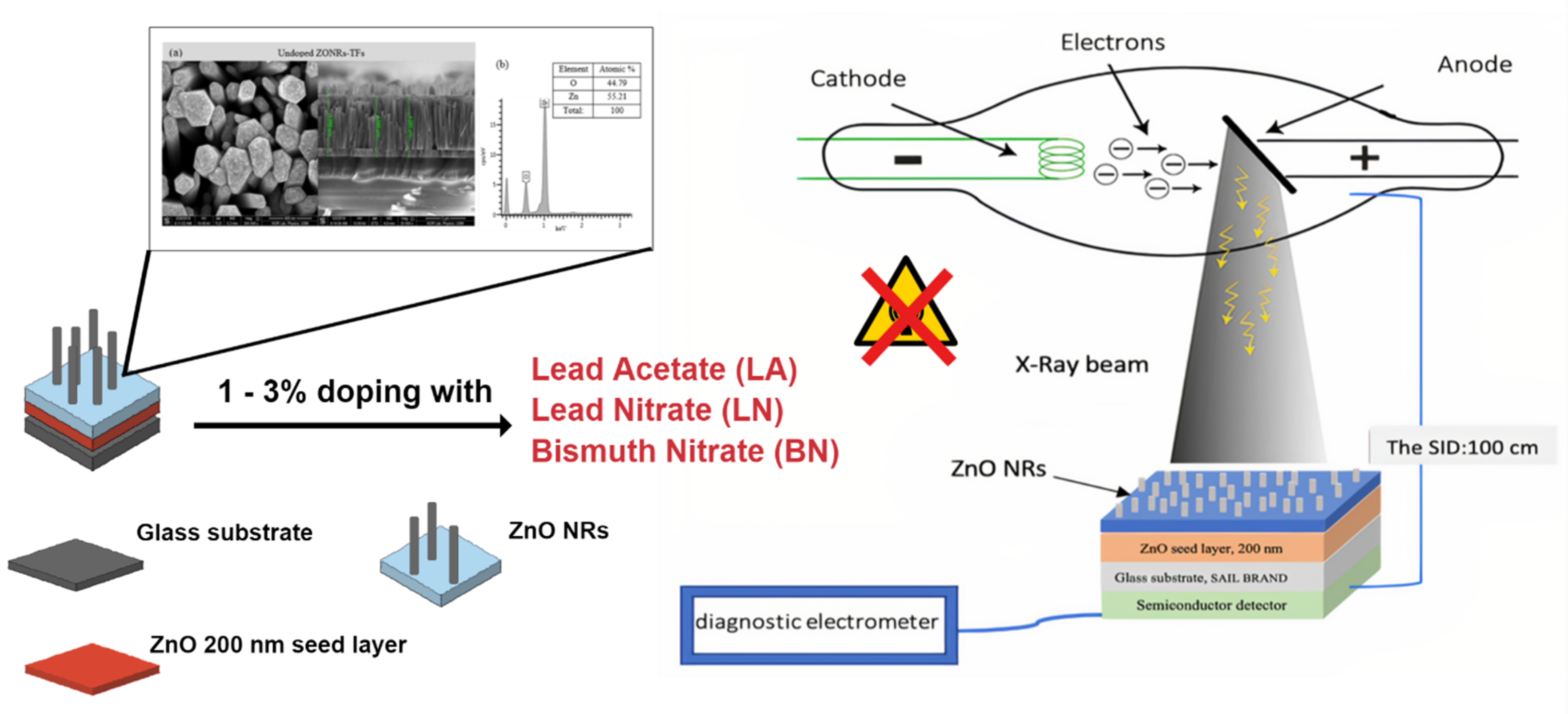

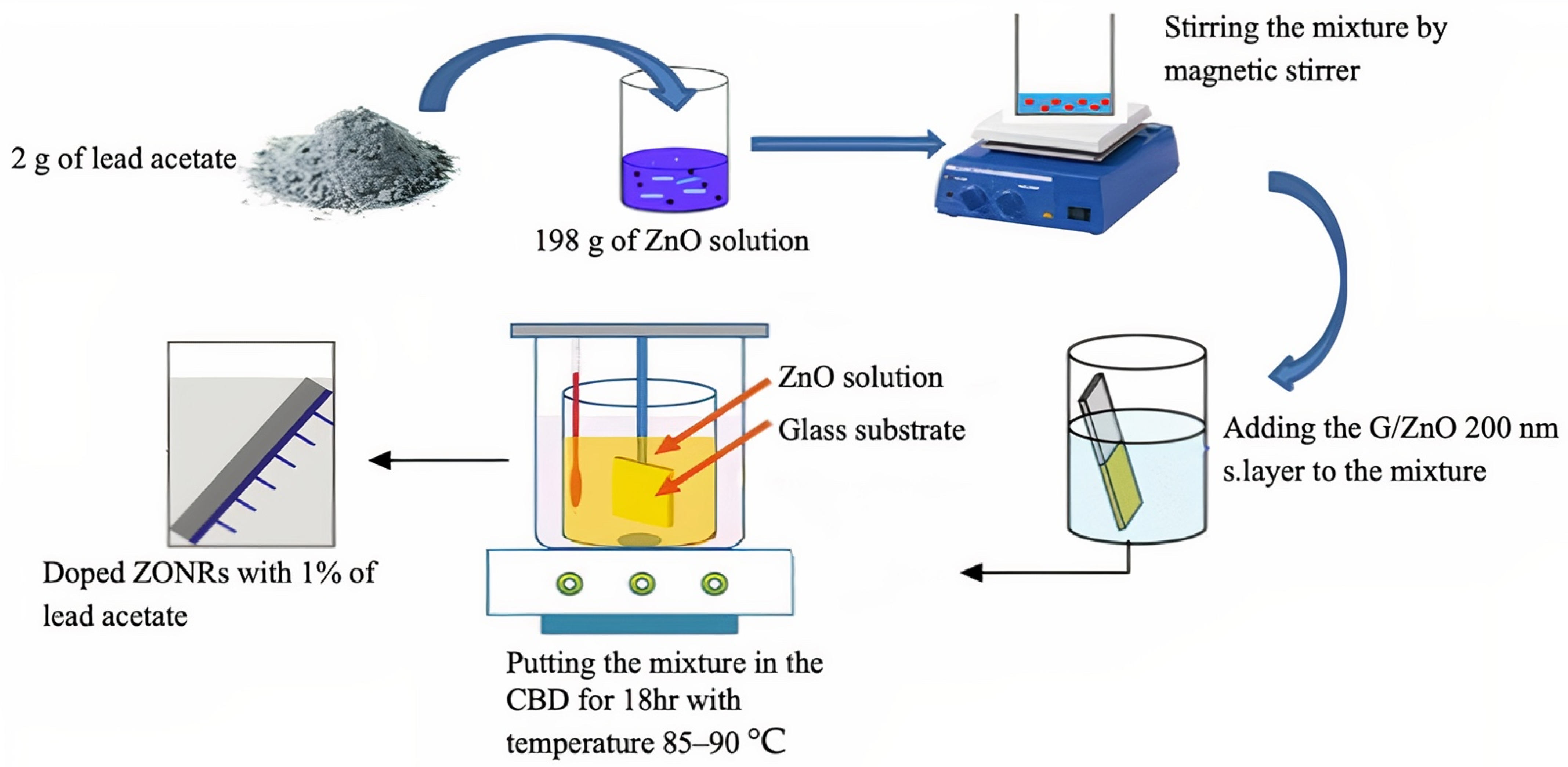
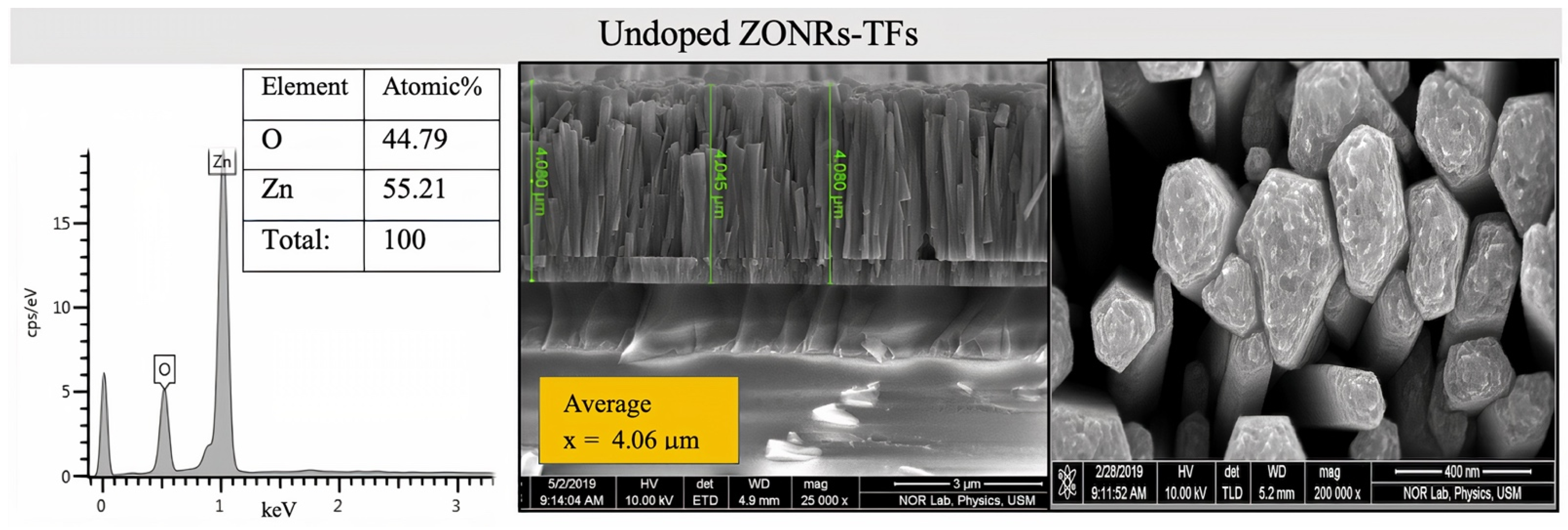
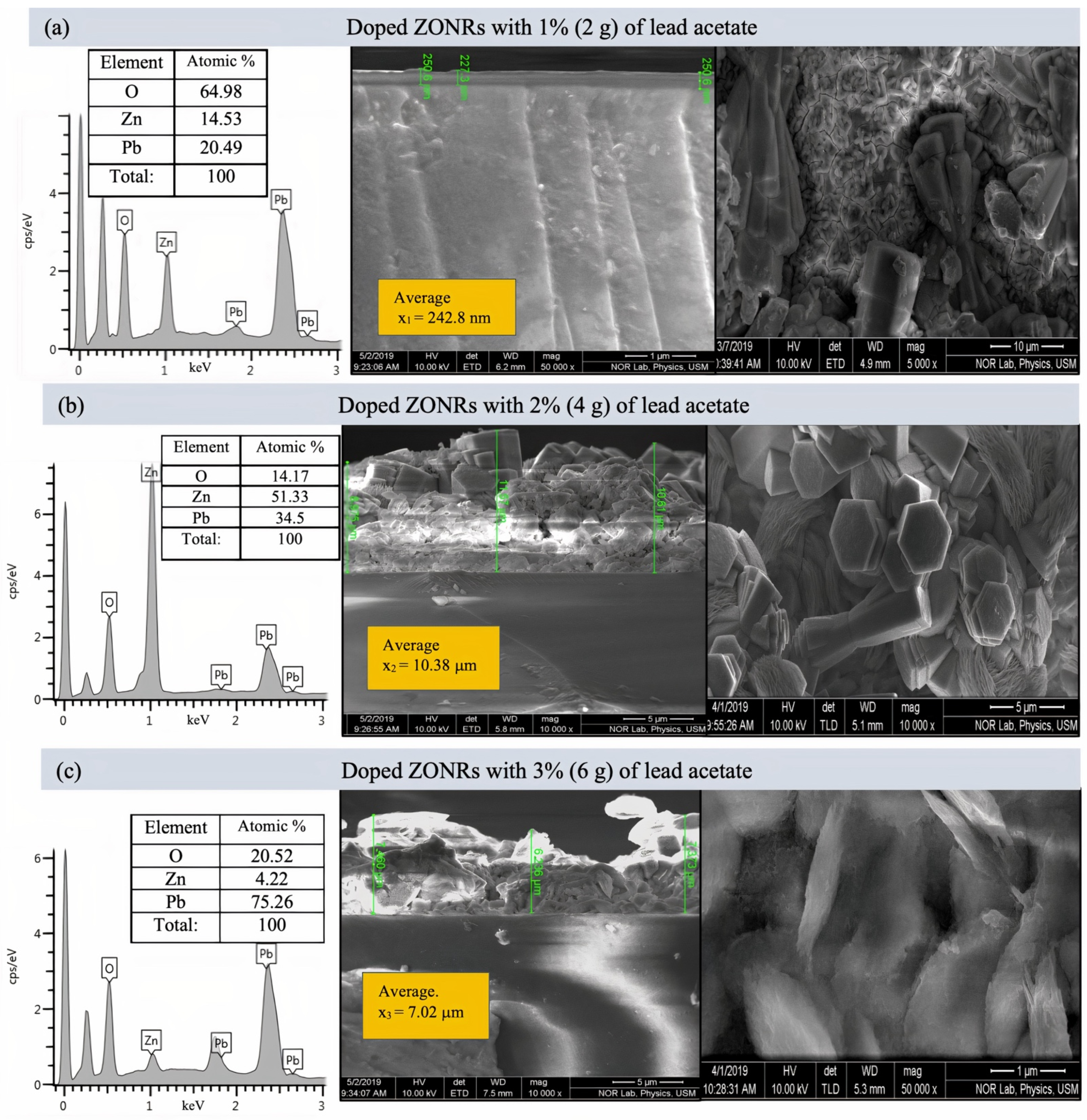
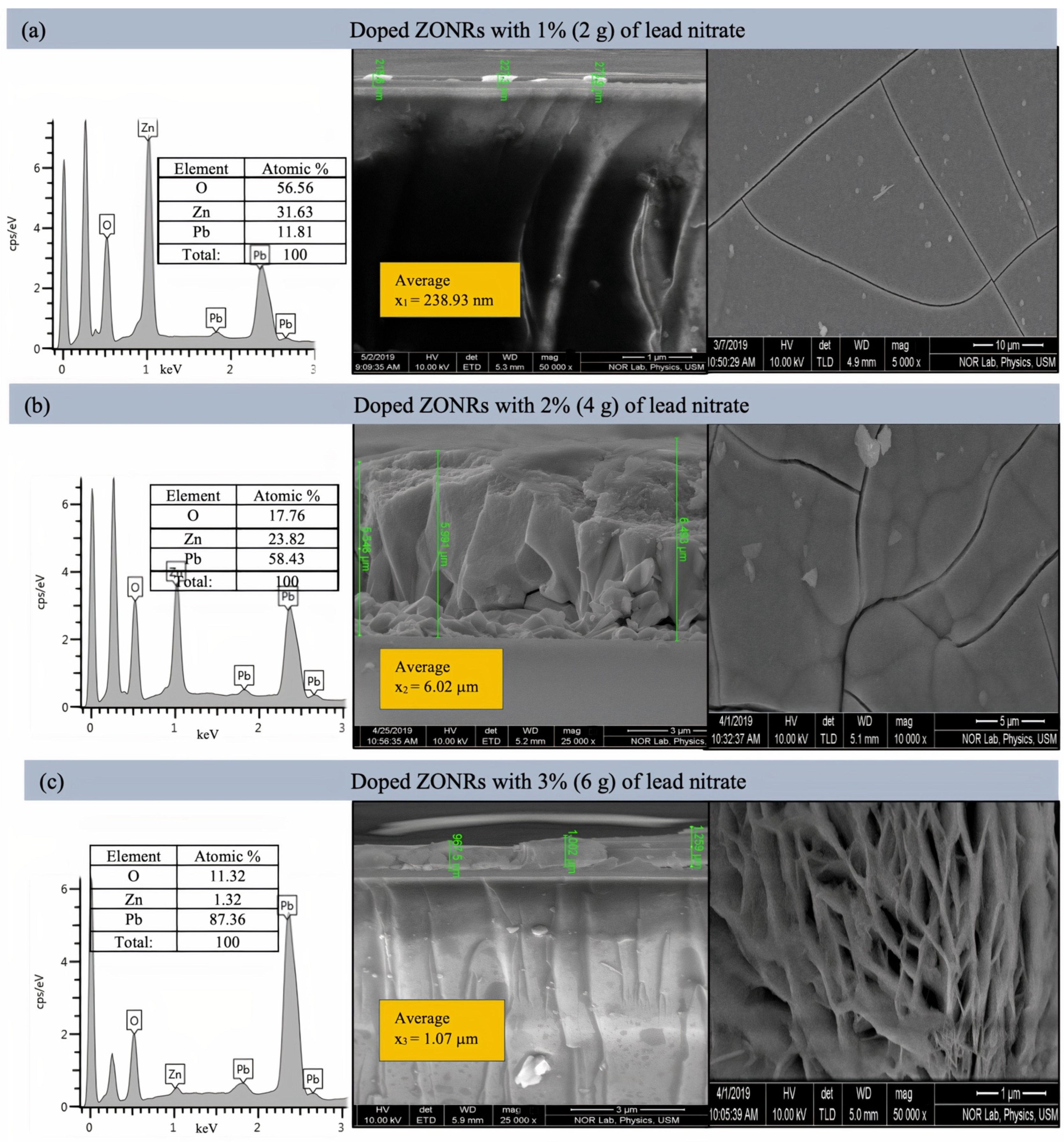
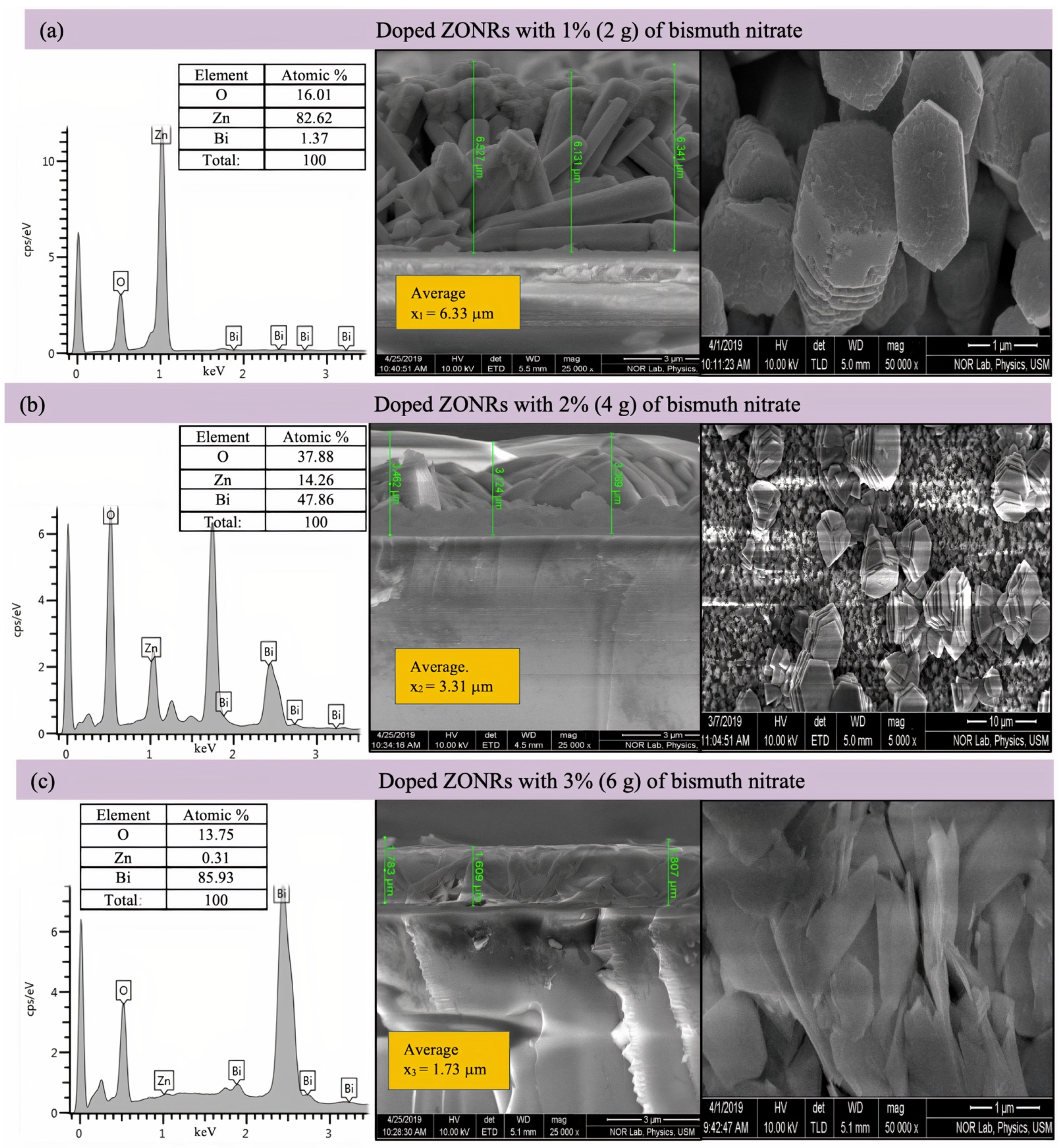
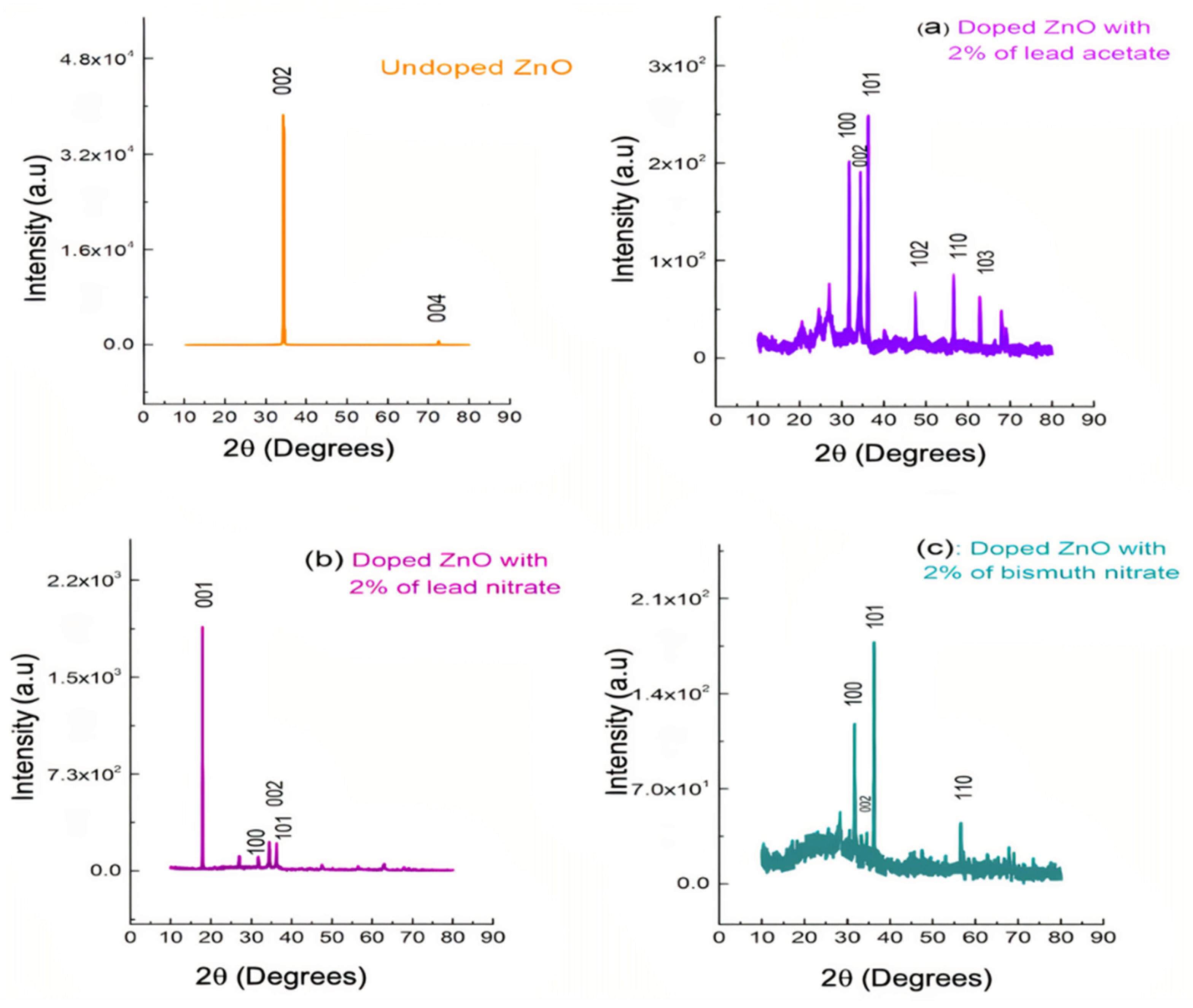
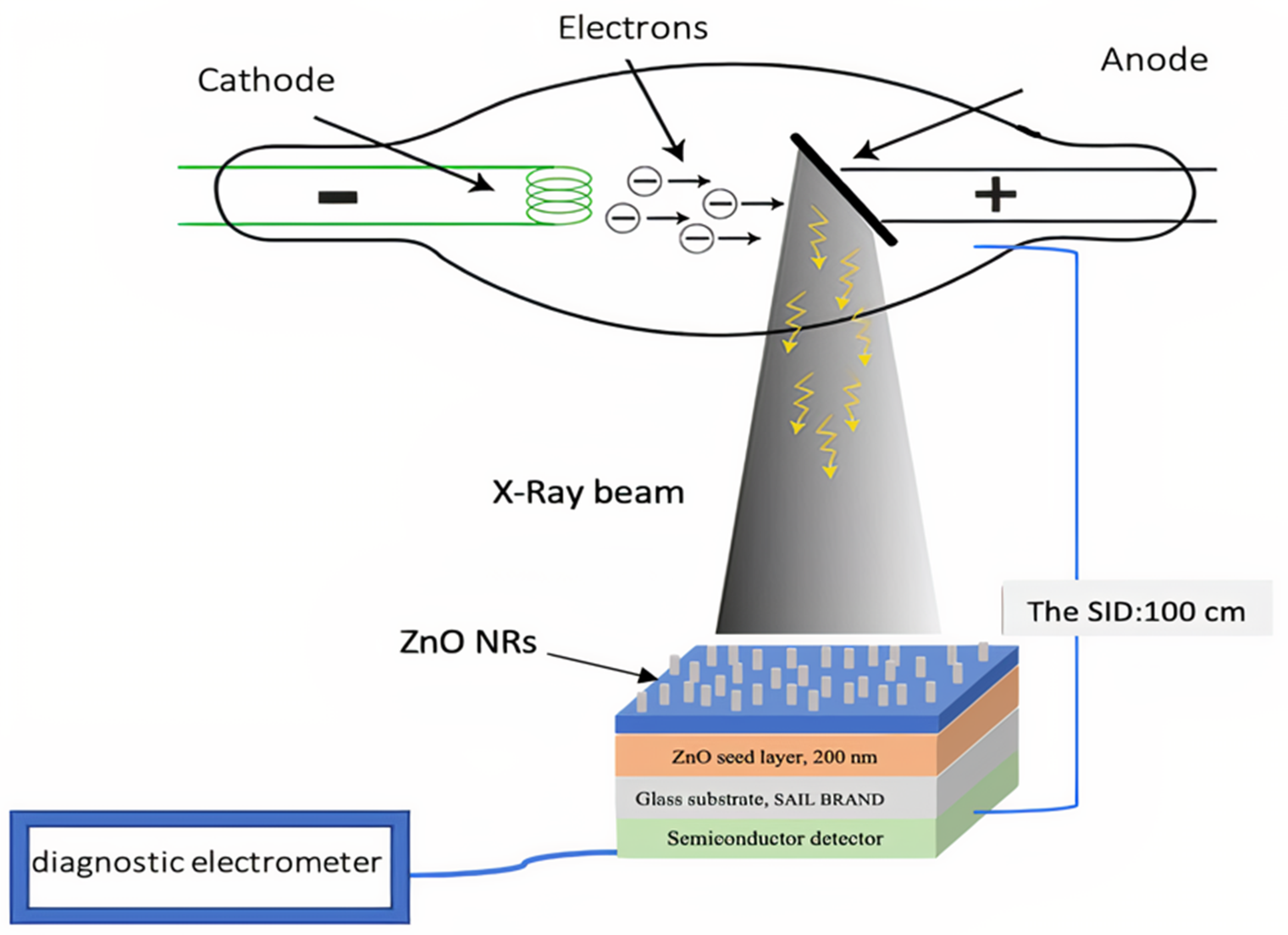


| Doping (wt.%) | Mass of Each Dopant (g) | Mass of ZnO (g) | Total Mass in Solution (g) |
|---|---|---|---|
| 1 | 2 | 198 | 200 |
| 2 | 4 | 196 | 200 |
| 3 | 6 | 194 | 200 |
| No | Sample | Thickness | Average | Standard Deviation | Thickness in (cm) | ||
|---|---|---|---|---|---|---|---|
| X1 | X2 | X3 | |||||
| LA-doped ZONRs-TFs | |||||||
| 1 | Doped 1% | 250.6 | 227.3 | 250.5 | 242.8 nm | ±13.4 nm | 2.42 × 10−5 |
| 2 | Doped 2% | 8.975 | 11.57 | 10.61 | 10.38 µm | ±1.31 µm | 10.38 × 10−4 |
| 3 | Doped 3% | 7.46 | 6.23 | 7.37 | 7.02 µm | ±0.68 µm | 7.02 × 10−4 |
| LN-doped ZONRs-TFs | |||||||
| 1 | Doped 1% | 215.6 | 227.3 | 273.9 | 238.93 nm | ±30.84 nm | 2.39 × 10−5 |
| 2 | Doped 2% | 5.548 | 5.991 | 6.493 | 6.01 µm | ±0.47 µm | 6.01 × 10−4 |
| 3 | Doped 3% | 0.9675 | 1.002 | 1.259 | 1.07 µm | ±0.15 µm | 1.07 × 10−4 |
| BN-doped ZONRs-TFs | |||||||
| 1 | Doped 1% | 6.527 | 6.131 | 6.341 | 6.333 µm | ±0.198 µm | 6.33 × 10−4 |
| 2 | Doped 2% | 3.462 | 3.124 | 3.369 | 3.318 µm | ±0.174 µm | 3.31 × 10−4 |
| 3 | Doped 3% | 1.783 | 1.609 | 1.807 | 1.730 µm | ±0.108 µm | 1.73 × 10−4 |
| ZONRs-TFs | Undoped | Doped of LA | Doped of LN | Doped of BN |
|---|---|---|---|---|
| Grain size (nm) | 10.44 | 13.86 | 13.72 | 38.98 |
| Doped ZONR-TFs with | Thickness | I (mA) | μ (cm−1) at Tube Voltage | ||
|---|---|---|---|---|---|
| 50 kVp | 70 kVp | 100 kVp | |||
| 1 wt.% of LA | 242.8 nm | 50 | 15,936.47 | 11,887.69 | 9220.81 |
| 100 | 13,920.34 | 11,394.77 | 9376.06 | ||
| 160 | 14,152.49 | 11,340.37 | 9220.81 | ||
| 200 | 15,333.21 | 11,887.69 | 9740.59 | ||
| 1 wt.% of LN | 239.9 nm | 50 | 12,777.47 | 10,138.64 | 8331.74 |
| 100 | 14,078.34 | 11,510.6 | 9264.97 | ||
| 160 | 13,939.1 | 11,643.5 | 9702.78 | ||
| 200 | 15,000.34 | 12,167.46 | 10,064.86 | ||
| 3 wt.% of BN | 1.73 μm | 50 | 1662.9 | 1473.37 | 1122.29 |
| 100 | 2001.6 | 1639.16 | 1289.85 | ||
| 160 | 1962.47 | 1530.01 | 1308.98 | ||
| 200 | 1972.85 | 1580.74 | 1315.26 | ||
Publisher’s Note: MDPI stays neutral with regard to jurisdictional claims in published maps and institutional affiliations. |
© 2021 by the authors. Licensee MDPI, Basel, Switzerland. This article is an open access article distributed under the terms and conditions of the Creative Commons Attribution (CC BY) license (https://creativecommons.org/licenses/by/4.0/).
Share and Cite
Al-Balushi, M.A.; Ahmed, N.M.; Zyoud, S.H.; Mohammed Ali, M.K.; Akhdar, H.; Aldaghri, O.A.; Ibnaouf, K.H. Ionization Radiation Shielding Effectiveness of Lead Acetate, Lead Nitrate, and Bismuth Nitrate-Doped Zinc Oxide Nanorods Thin Films: A Comparative Evaluation. Materials 2022, 15, 3. https://doi.org/10.3390/ma15010003
Al-Balushi MA, Ahmed NM, Zyoud SH, Mohammed Ali MK, Akhdar H, Aldaghri OA, Ibnaouf KH. Ionization Radiation Shielding Effectiveness of Lead Acetate, Lead Nitrate, and Bismuth Nitrate-Doped Zinc Oxide Nanorods Thin Films: A Comparative Evaluation. Materials. 2022; 15(1):3. https://doi.org/10.3390/ma15010003
Chicago/Turabian StyleAl-Balushi, Mohamed Abdulsattar, Naser M. Ahmed, Samer H. Zyoud, Mohammed Khalil Mohammed Ali, Hanan Akhdar, Osamah A. Aldaghri, and Khalid Hassan Ibnaouf. 2022. "Ionization Radiation Shielding Effectiveness of Lead Acetate, Lead Nitrate, and Bismuth Nitrate-Doped Zinc Oxide Nanorods Thin Films: A Comparative Evaluation" Materials 15, no. 1: 3. https://doi.org/10.3390/ma15010003
APA StyleAl-Balushi, M. A., Ahmed, N. M., Zyoud, S. H., Mohammed Ali, M. K., Akhdar, H., Aldaghri, O. A., & Ibnaouf, K. H. (2022). Ionization Radiation Shielding Effectiveness of Lead Acetate, Lead Nitrate, and Bismuth Nitrate-Doped Zinc Oxide Nanorods Thin Films: A Comparative Evaluation. Materials, 15(1), 3. https://doi.org/10.3390/ma15010003








